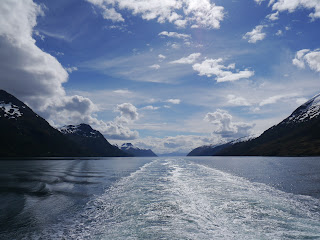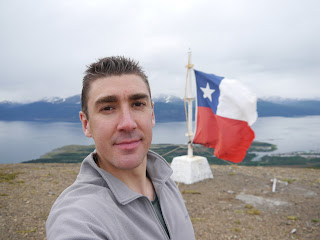For a full complement of photos, follow this link to the set my Flickr account:
2011, 21st & 22nd November: Punta Arenas, Chile
Spent waiting in Punta Arenas for the (once-weekly) ferry to Puerto Williams. A chance to catch-up on my photo-uploading in the first location in 5 weeks or so with a good(ish) internet connection.
23rd & 24th November: A Voyage on Ferry Yaghan from Punta Arenas to Puerto Wiliams
This 28 hour ferry journey is a far cry from any I have taken before (such as those across the English Channel or the North and Irish Seas). The geography at this southern-most end of the continent of South America is a myriad of narrow channels, islands, islets and inlets - making for some stunning views and a very memorable voyage. The area has a rich maritime history as it was through these naval waterways that explorers such as Magellan and Cook sought passages linking the Atlantic and Pacific Oceans (until the voyages of Magellan it was not known whether such routes to the Far-East existed).
Magellan discovered the northern route (named the Magellan Straights) which lie between the mainland and the large island of Tierra del Fuego (land of the fire; so named by the first voyagers after they saw the fires of the natives that lived there). Captain Cook chartered the southern route (the Beagle Channel) which lies between Tierra del Fuego and the Chilean island of Isla Navarino.
The ferry voyage took us through the Magellan Strait, and the O´Brien, Darwin, Ballenero, Beagle, Magdelena, Cockburn, Ocasión and Brecknock channels - so the captain and crew had to keep their navigational wits about them.
The narrow passages navigated by the ferry throughout the majority of the journey provided a constant close view of the edges of the channels formed by islets, mountain slopes, glaciers and countless small inlets. The weather was clear and windless, so for much of the journey I marveled at the views across a perfectly calm channel (like a mill pond). I was lucky to have the company of two French women (Chamille and Marie) that I met the previous week in Puerto Natales.
Early Morning View Approaching One of the Many Narrow Passages On-Route
Ferry Yaghan with a Wonderful Backdrop
I enjoyed yet more amazing Patagonian skies with vast views to the far horizon across multi-layered clouds sitting in a rich sky - a true tapestry of numerous tones of blue and white, (what creates these amazing Patagonian skies - is it the clarity of the air)?
Ah....Those Southern Patagonian Skies.....
A Glacier ´Tumbling´ Into our Seaway
25th & 26th November: Puerto Williams, Chile
Puerto Williams on the island of Isla Navarino (across the Beagle Channel from the (much larger) island of Tierra del Fuego)) is the southern-most (notable) town in the world (despite what the Argentines may claim about Ushuaia on Tierra del Fuego). As one might expect for such an out-post, there is not a lot happening in Puerto Williams, but it serves as a good base for walks around the peaks of the Dientes de Navarino (the ´Teeth of Navrino´) - so called because of the teeth like line of mountain peaks.
While there, I made a one day trek to see the peaks (one day was enough as I must say that after so much mountain trekking in Patagonia, me and (my knees in particular) feel a bit walked-out for the time being). While on my trek I was fortunate to see a condor sitting on an outcrop just 15 metres away. Throughout the remainder of the walk, I continued to see him demonstrating his effortless use of thermals.
A Condor Surveys the Valley Below
(of Valley of Rio Ukika on Isla de Navarino)
La Dientes de Navarino (The Teeth of Navarino) With Laguna el Salto Below
Tim in the Deep, Deep South of America: At the Mirador (View-Point) above Puerto Williams With the Beagle Channel Behind Me
27th to 30th November: Ushuaia, Argentina
The journey across the Beagle Channel from Puerto Williams (Chile) to Ushuaia (Argentina) is not easy (nor is it cheap) as there are no timetabled crossings, just fast launches (boats) or small planes which will only make the journey if there are sufficient passengers wanting to make the crossing. I elected to take the fast launch so enjoyed a rapid 75 minute boat ride.
The Fast Launch I Took from Puerto Williams to Ushuaia (Across the Beagle Channel)
I travelled to Ushuaia so that I could catch a flight to Buenos Aires where I will take a ferry across the Rio de la Plata to Uruguay. My time in Ushuaia was mainly spent planning the Uruguayan leg of my travels. I did however, make time out to join a couple of friends from the hostel to visit the maritime museum which is housed in an old prison (many of the exhibits are in the old cells). It provides a history of the early naval exploration of this area, the Yámanas (indigenous people who used to live on Tierra del Fuego), Antarctic expeditions and the prison itself.
Some great laughs were provided by some poor translations:
"He placed a plaque at Cape Horn for the survivors of the sucked ships.." I guess the ships were sucked and sucked until they sunk!
The following text may not be in error, but simply a weird quote:
"They had few choices: Brazil, Uruguay or Argentina. The choice was easy: A big country, simple settling down formalities and no need of going into the forest". From this I assume that in Uruguay and Brazil you are woken at 4am every day for your obligatory walk into the forest - either that or there are no toilets at all and one has to go behind a tree to squat!
The following is a wonderful example of Edwardian British pomposity written by Dulse in 1902. It relates to the anthropological description of the Yámana people who were documented by the likes of Darwin et al:
"They are short and ugly, figures of crooked and contracted legs in whom Darwin is thought to have found the missing link". Flip, don´t expect to get invited round to their place for tea!









































